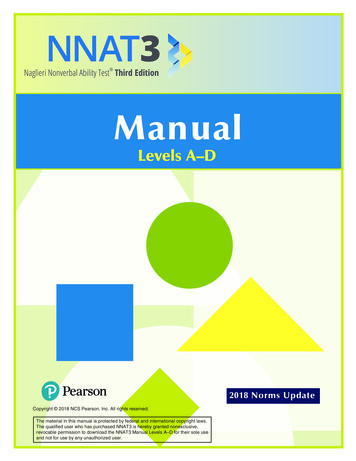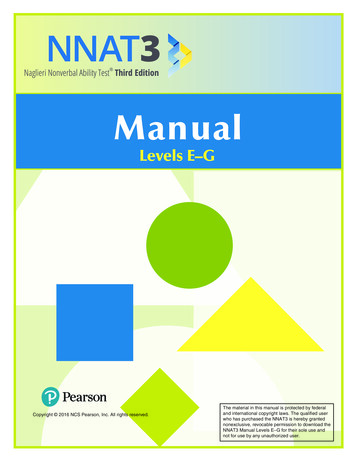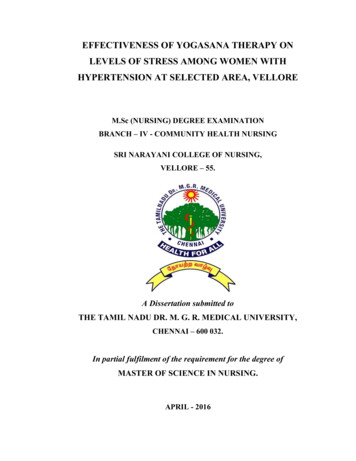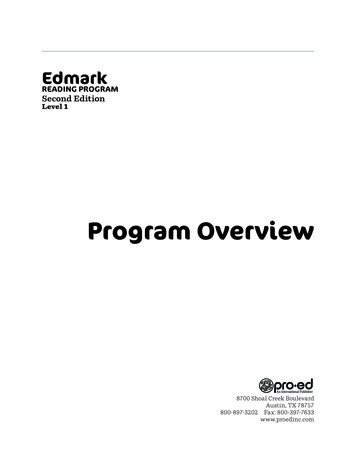
Transcription
ManualLevels A–D2018 Norms UpdateCopyright 2018 NCS Pearson, Inc. All rights reserved.The material in this manual is protected by federal and international copyright laws.The qualified user who has purchased NNAT3 is hereby granted nonexclusive,revocable permission to download the NNAT3 Manual Levels A–D for their sole useand not for use by any unauthorized user.
Copyright 2018 NCS Pearson, Inc. All rights reserved. Portions of this work were previously published.Normative data copyright 2018 NCS Pearson, Inc.Warning: No part of this publication may be reproduced or transmitted in any form or by any means, electronic or mechanical,including photocopy, recording, or any information storage and retrieval system, without the express written permission of thecopyright owner.The NNAT3 Score Record page is reproducible for administrative purposes only.Pearson, Naglieri Nonverbal Abilities Test, and NNAT are trademarks, in the US and/or other countries, of PearsonEducation, Inc., or its affiliates.NCS Pearson, Inc., 5601 Green Valley Drive, Bloomington, MN 55437
About the AuthorJack A. Naglieri, Ph.D., is Research Professor at the Curry School of Educationat the University of Virginia, Senior Research Scientist at the Devereux Centerfor Resilient Children, and Emeritus Professor of Psychology at George MasonUniversity. He is a Fellow of APA Divisions 15 and 16, recipient of the 2001 SeniorScientist Award for APA Division 16 and the 2011 Italian American PsychologyAssembly Award for Distinguished Contributions to Psychology, is a Diplomatein Assessment Psychology, earned a license as a School Psychologist in Virginiaand Ohio, and earned School Psychology certifications in New York, Georgia,Arizona, and Ohio. Dr. Naglieri has focused his professional efforts on theoreticaland psychometric issues concerning intelligence, cognitive interventions, diagnosisof learning and emotional disorders, and theoretical and measurement issuespertaining to protective factors related to resilience.Dr. Naglieri is the author or coauthor of more than 250 scholarly papers, books,and tests. His scholarly research includes investigations related to exceptionalitiessuch as mental impairment, specific learning disabilities, giftedness, and AttentionDeficit Disorder; psychometric studies of tests such as the Wechsler Scales ofIntelligence, Cognitive Assessment System, and the Kaufman Assessment Batteryfor Children; examination of race, gender, and ethnic differences in cognitiveprocessing; fair assessment using nonverbal and neurocognitive processing tests;identification of gifted minorities, IDEA and identification of specific learningdisabilities; and cognitively based mathematics interventions. He has authoredvarious books, including Essentials of CAS Assessment (Naglieri, 1999), andcoauthored books such as Assessment of Cognitive Processes: The PASS Theory ofIntelligence (Das, Naglieri, & Kirby, 1994), Helping Children Learn: InterventionHandouts for Use at School and Home, Second edition (Naglieri & Pickering,2010), Essentials of Wechsler Nonverbal Assessment (Brunnert, Naglieri, &Hardy-Braz, 2009), and Helping All Gifted Children Learn: A Teacher’s Guideto Using the NNAT2 (Naglieri, Brulles, & Lansdowne, 2009). Dr. Naglieri hasalso coedited books such as Handbook of Assessment Psychology (Graham &Naglieri, 2002), Assessment of Autism Spectrum Disorders (Goldstein, Naglieri,& Ozonoff, 2009), Assessing Impairment: From Theory to Practice (Goldstein& Naglieri, 2009), A Practitioner’s Guide to Assessment of Intelligence andAchievement (Naglieri & Goldstein, 2009), and Handbook of Executive Function(Goldstein & Naglieri, 2013).Dr. Naglieri’s scholarly efforts also include development and publication of testsand rating scales. He began this work in the mid-1980s with the publication of theMatrix Analogies Tests (Naglieri, 1985), which became the Naglieri NonverbalAbility Test—Multilevel Form (Naglieri, 1997), Naglieri Nonverbal Ability Test—Second Edition (2008) and now the Naglieri Nonverbal Ability Test—Third Editioni
(2016). He also published the Wechsler Nonverbal Scale of Ability (Wechsler &Naglieri, 2008), the Devereux Student Strength Assessment (LeBuffe, Shapiro,& Naglieri, 2009), the Autism Spectrum Rating Scale (Goldstein & Naglieri,2009), the Comprehensive Executive Functioning Index (Naglieri & Goldstein,2013), and the Cognitive Assessment System—Second Edition (Naglieri, Das andGoldstein, 2014).ii
TABLE OF CONTENTSAbout the Author .iChapter 1Purpose and Design of NNAT3 Levels A–D .1Design .2Administration .4Uses of NNAT3 .5Chapter 2Interpretation and Applications .6Types of Scores.6Applications and Uses of NNAT3 .9What does the NNAT3 Measure? . 10Chapter 3Content Development, Standardization, andNorms Development . 14Item Creation . 14Item Tryout . 14Standardization . 17Test Administration .19Norms Development . 19Norm Sample .19Norms Construction .21Development of Final Forms. 23Chapter 4Evidence of Reliability and Validity . 24Reliability . 24IRT-Based Reliability.24Alternate-Form Reliability.25Validity. 28Correlation with NNAT2 .28Correlation with Otis-Lennon School Ability Test,Eighth Edition (OLSAT 8) .29iii
Other Studies .30Comparison of Online and Paper Administration.30Chapter 5NNAT3 Lower Levels 2018 Norms Update . 32Sampling Procedures .32Norms Development .33Comparison of NNAT3 2015 and 2018 Updated Lower-Level Norms .34Standard Error of Measurement .35Re-Analysis of Validity Studies . 35Appendix A: Scaled Scores Corresponding to Raw Scoresby Level, Form, and Administration Mode . 39Appendix B: Naglieri Ability Indexes Corresponding to Scaled Scores by Age,Based on 2018 Updated Norms . 41Appendix C: Percentile Ranks, Stanines, and Normal Curve Equivalents (NCE)Corresponding to Naglieri Ability Index (NAI) Scores . 69Appendix D: List of Schools Participating in 2015 Standardization . 71References . 74iv
LIST OF TABLESTable 1.1. Grade and Valid Age Range for Each NNAT3 Level .4Table 3.1. Distribution of Gender and Ethnicity in the Tryout Sample . 16Table 3.2. Difficulty of Items on NNAT3 Standardization Forms 1 and 2 . 18Table 3.3. Numbers of Cases by Age in the NNAT3 Norm Sample .20Table 3.4. Demographic Characteristics of the NNAT3 Norm Sample .21Table 3.5. Number and Source of Replacement Items on NNAT3 Final Forms.23Table 4.1: IRT-Based Reliabilities by Level and Form .25Table 4.2. Alternate-Form Reliability (Online), by Level .26Table 4.3. Alternate-Form Reliability (Online-Paper), by Level .27Table 4.4. Correlations between NNAT3 and NNAT2 NAI Scores .29Table 4.5. Correlations between NNAT3 and OLSAT 8 Scores .30Table 4.6. Comparison of NNAT3 Scaled Scores from Paper andOnline Administrations. 31Table 5.1. Demographic Characteristics of the NNAT3 2018 Updated Norms Sample.33Table 5.2. Comparison of NAI Scores from the 2015 Norms and 2018 Updated Norms .34Table 5.3. Standard Error of Measurement of 2018 NAI Scores, by Level.35Table 5.4. Correlations between NNAT3 (2018 Updated) and NNAT2 NAI Scores .36Table 5.5. Correlations between NNAT3 (2018 Updated) and OLSAT 8 Scores .36v
vi
PURPOSEANDCHAPTER 1DESIGN OF NNAT3 LEVELS A–DThe Naglieri Nonverbal Ability Test —Third Edition (NNAT3 Levels A–D) isa brief, nonverbal measure of general ability that can be group administered in onlineor paper format in about 30 minutes to students aged 5 to 11.a For information aboutNNAT3 Levels E–G (grades 5–12), please see the NNAT3 Levels E–G Manual. Thepurpose of the NNAT3 is to measure general ability using abstract designs whichare accessible to a wide variety of students including those with limited educationalexperiences, those who come from diverse cultural, socioeconomic, or linguisticbackgrounds, and those who have language disabilities, autism spectrum disorder,or are deaf or hard of hearing. Because the NNAT3 items consist of geometricshapes that are universal and have no verbal content, and the directions are pictorialwith minimal verbal instructions, NNAT3 has great utility as part of the process ofidentifying students for gifted/talented educational programs, especially for membersof groups that have been underrepresented.The NNAT3 is the latest in a series of related instruments spanning thirty years.It is a revision of the Naglieri Nonverbal Ability Test—Second Edition (NNAT2;Naglieri, 2007), which is based on the Naglieri Nonverbal Ability Test—MultilevelForm (NNAT-ML; Naglieri, 1997). The original instruments in this series were theMatrix Analogies Test—Expanded Form (MAT-EF; Naglieri, 1985a) and MatrixAnalogies Test—Short Form (MAT-SF; Naglieri, 1985b).The NNAT3 measures the student’s ability to look at a pattern that has a missingsection, understand the relationships among the parts, and determine which of the fiveoptions correctly fills the gap. An example is shown in Figure 1.1. In this example,the student needs to comprehend the relationships between the two diamonds in thetop row and the diamond and triangle in the left column. When the horizontal andvertical relationships are understood, then the answer (option 1) becomes clear.Figure 1.1. Example of an NNAT3 ItemNorms are also provided for children aged 4:0–4:11 so that NNAT3 Level Amay be used with high-ability preschoolers. However, because of its difficulty,the test is not appropriate for general use with children younger than 5 years old.a1
NNAT3 Manual Levels A–DThe kind of thinking required to solve a question like this one, made upof shapes and colors, is essentially the same as the thinking required to solvea verbal question such as “Girl is to woman as boy is to . . . ?” In this case therelationships between girl and woman as well as girl and boy must be understoodto arrive at the answer “man.” Although the thinking is the same whether one isreasoning with words or with shapes, one type requires knowledge of a particularlanguage and, usually, the ability to read, whereas the other type does not requirethese skills.The NNAT3 measures general ability—a widely used concept that hasbeen studied since the early 1900s. Naglieri, Brulles, and Lansdowne (2009)described general ability as what allows people to solve a number of differentkinds of problems that may involve words, pictures, sounds, or numbers. It mayalso require verbal, quantitative, or nonverbal reasoning; memory; sequencing;pattern recognition; insights; drawing inferences; and analyzing simple andcomplex ideas. In modern conceptions of ability, the particular type of thinkingthat NNAT3 questions require—that is, seeing relationships among componentsof the question and thinking of rules that can explain those relationships—isconsidered to be closely related to general ability (Carroll, 1993). Thus, it isnot surprising that the various versions of NNAT have been found to be goodpredictors of academic achievement for students in diverse racial/ethnic groups orfrom diverse language backgrounds. The power of the concept of general abilitymakes this a useful approach for large-scale testing.DesignThe NNAT3 consists of four levels (A, B, C, and D), each of which isdesigned specifically for students in the corresponding grade (i.e., K, 1, 2, and3–4, respectively). Although kindergarten, Grade 1, and Grade 2 each have theirown level, Level D is administered to students in Grades 3 and 4. Separate levelsare provided for kindergarten through second grade because of the significantamount of development in ability that occurs during each of the early schoolyears.Unlike the previous versions of the test, the NNAT3 Levels A–D has twoparallel forms (Form 1 and Form 2) at each level. The parallel forms are similarin the types of items they contain and in their level of difficulty, and they haveno common items. This makes them useful in situations requiring repeatedadministrations, such as evaluating students’ progress over time or measuringthe effectiveness of an intervention or program. Additionally, the lack of commonitems across forms helps to maintain item and test security.2
NNAT3 Manual Levels A–DEach form consists of 48 carefully selected items, arranged in approximateorder of difficulty. The items were chosen based on content and level of difficulty.There are common items between adjacent levels within a form (for example,between Levels B and C of Form 1). The specifics of the item-selection andform-development processes are described in later sections of this manual.Although NNAT3 Levels A–D items are similar to NNAT2 items, they areall new. Test development was guided by the need to provide items of appropriatedifficulty at every level and to vary the structure of the items. For example, theeasiest items present a large rectangle with a piece missing (see an example inFigure 1.2). The child must choose the option that would complete the largerimage, relying on an understanding of how the entire image is organized.Figure 1.2. Example of an NNAT3 Item with Missing PieceMore difficult items show a set of images in a 2-by-2, 2-by-3, or 3-by-3array. The elements of a relatively easy item form a simple pattern as shown inFigure 1.3. In this example, the student must recognize changes in shape andcolor across the horizontal and vertical dimensions to arrive at the correct answer.The items become more complex and difficult when there is an increase in thenumber of visual features and in the ways in which they can change (e.g., size,rotation, addition, or progression). This method of item development provided afull range of difficulty necessary to create norms which would measure abilitynonverbally for a wide variety of individuals.Figure 1.3. Example of an NNAT3 Item with Changes in Color and Shape3
NNAT3 Manual Levels A–DAdministrationThe NNAT3 is designed to be administered to groups of students. Atgrades 2 and above, it can be given to entire classrooms, but smaller groups arerecommended at kindergarten (up to five students) and Grade 1 (up to ten students).At any grade level, it is permissible to administer the NNAT3 to a single student.The teacher reads the directions (in the language appropriate for thestudents) and leads the students through sample items, but once the actual testbegins, the students work on their own. Students have 30 minutes to work on thetest questions, and the overall administration, including directions, takes about35 to 45 minutes.The NNAT is considered a power test; that is, it is designed to measure theabilities of the test taker, regardless of his or her speed of performance. Powertests contain items with varying degrees of difficulty and allow enough time fortest takers to attempt all items. Based on results from tryout and standardization,most students were able to complete the NNAT3 within 30 minutes. Additionally,a study comparing students who were given additional time to complete theNNAT2 versus those who were not found that students who got additional timedid not obtain higher scores. As a result, the 30-minute administration time wasdeemed appropriate for the NNAT3.Both the paper-and-pencil and computer-based versions of the NNAT3are available at all levels. With paper administration at kindergarten and Grade1, students mark their answers directly in a consumable, machine-scorable testbooklet. At Grades 2–4, students may use either the consumable booklet or areusable booklet with a separate machine-scorable answer sheet.The choice of NNAT3 level to administer is based on the student’s grade,although the norms for the NNAT3 are based on age. The items at any givenlevel span a wide range of difficulty so that the level is appropriate for studentsof different ages at that grade. If necessary, a student may be tested “out of level”(that is, using a level intended for a different grade), as long as the student’s ageis within the range of valid ages shown in Table 1.1.Table 1.1. Grade and Valid Age Range for Each NNAT3 Level4LevelGrade(s)Valid Age Range(year:month)ABCDKindergarten123–44:0 to 7:115:0 to 9:116:0 to 10:117:0 to 11:11
NNAT3 Manual Levels A–DUses of NNAT3The NNAT3 is well suited to evaluating general ability in a wide variety ofchildren. It is a good predictor of academic achievement and is effective as part ofthe process of identifying gifted and talented students. In addition, the NNAT3 hasseveral features that make it desirable for assessing diverse populations. The useof nonverbal test questions and pictorial directions enables valid and interpretableresults to be obtained for students with varied linguistic or cultural backgrounds,such as English language learners. That is, the NNAT3 is particularly valuablefor those who cannot be effectively and fairly assessed using tests with itemsthat require knowledge and use of a particular language. These features are alsobeneficial for assessing students with developmental delays or challenges, thedeaf and hard of hearing, students with autism spectrum disorder, and studentswith little or no schooling.The NNAT3, therefore, has two primary uses. The first is to help inthe identification of gifted and talented students, especially those from underrepresented groups; this use addresses one of the most serious challenges facingeducators of gifted and talented students. The second use is to provide a measureof general ability for students of all ability levels for whom a language-freeassessment is required.5
CHAPTER 2INTERPRETATION AND APPLICATIONSNNAT3 results, like those from any test, should be interpreted in light ofthe student’s background, including classroom performance, social-emotionalskills, motivation, and language skills. This chapter provides information designedto assist users in interpreting NNAT3 scores when making decisions abouteducational placement.Types of ScoresThe various types of scores provided for the NNAT3 have different usesand yield different kinds of information. Therefore, users should focus theirinterpretation on the particular score types that are most relevant to the purposefor which the test was administered. The score types are described in the followingsection. Please see the appendices at the end of this manual for score tables.Raw ScoresThe raw score is the number of items answered correctly. Raw scores arethe basis for scaled scores (described below), but by themselves they providelittle information about the level or quality of student performance. They can beinterpreted only in reference to the number of items on the test.Scaled ScoresThe scaled-score system is based on a continuous scale of performancethat spans across Levels A to D of the NNAT3. A higher scaled-score valueindicates that the student was successful on more difficult items. A raw scoreon any NNAT3 level has a corresponding scaled-score value. A particular rawscore will convert to a higher scaled score on a higher (more difficult) NNAT3level than on a lower level.Because the scaled-score system links all levels of the test together, it canbe used to compare the performance of students taking different levels of the test.Once a raw score has been converted to its corresponding scaled score, the levelthat was administered is no longer relevant. This makes scaled scores especiallysuitable for comparing scores from different levels of the test, for studying growthin performance over time, and for testing out of level. The normative scoresdescribed below (NAI, percentile rank, stanine, and normal curve equivalent)are all based on the scaled score and the age of the examinee, rather than the rawscore.6
NNAT3 Manual Levels A–DNormative ScoresNormative scores describe how the student’s performance (scaled score)compares with the performance of other students of the same age in a nationallyrepresentative norm sample. For most purposes, normative scores are the mostuseful basis for interpretation. Because the NNAT3 is a measure of ability ratherthan academic achievement, the normative scores are based on age rather thangrade.Naglieri Ability Index (NAI)The Naglieri Ability Index (NAI) is a score on a scale that ranges from 40to 160, with an average of 100 and a standard deviation of 16. An NAI of 100represents the score that is the average for students of the same age. About68% of students in the norm sample score within one standard deviation of100 (that is, between NAIs of 84 and 116), and about 95% score within twostandard deviations (68 to 132). Because NAIs are normalized standard scores,the relationship of NAIs to percentile ranks and stanines is the same for allages and all NNAT3 levels.Percentile RankThe percentile rank indicates the percentage of students of that age in thenorm sample who scored at or below that scaled score. As noted above, thereis a constant relationship between NAIs and percentile ranks. For example,an NAI of 116 converts to a percentile rank of 84, meaning that 84 percentof students in the norm sample earned NAIs of 116 or lower. An NAI of 100corresponds to a percentile rank of 50, representing the average NAI forstudents in the norm sample.Percentile ranks are valuable because they are easily interpreted andexplained. However, they have certain disadvantages. One is that they are oftenconfused with “percentage correct.” Another is that a given size differencebetween percentile ranks has different meaning at different score levels;for example, the difference in ability between percentile ranks of 90 and95 is much greater than that between percentile ranks of 50 and 55. Thischaracteristic results from the concentration of most scaled scores near themiddle of the distribution, with relatively few scores at the extremes. Thus,although percentile ranks are very useful for describing the relative standingof a student within the reference group, they are less useful in describingdifferences between scores (such as between the scores of two students, orbetween a student’s scores at different times). Because they are not an equalinterval scale, percentile ranks cannot be averaged or used in arithmeticalcomputations such as addition or subtraction.7
NNAT3 Manual Levels A–DStanineThe stanine scale is a simplified version of the NAI scale. Stanines rangefrom 1 to 9 with an average of 5. The nine units of the stanine scale representequal differences in ability; for example, the difference in ability betweenstanines 7 and 9 is the same as the difference in ability between stanines1 and 3. Therefore, stanines may be averaged or used in other arithmeticalcomputations.In general, stanines 1, 2, and 3 are considered to ref lect below-averageperformance; stanines 4, 5, and 6 reflect average performance; and stanines 7,8, and 9 reflect above-average performance. Because stanine units are broaderthan those of the NAI and percentile rank scales, they possess somewhatgreater stability and reduce the likelihood of misinterpretations of smalldifferences in test scores.Normal Curve EquivalentThe normal curve equivalent (NCE) is another version of the NAI scale,this time with an average of 50 and a standard deviation of 21.06. Like NAIsand stanines, NCE scores can be used in arithmetical calculations such asaveraging. The benefit of the NCE scale is that NCE scores of 1, 50, and 99have percentile ranks of 1, 50, and 99, which may assist in interpretation.All of the normative scores described in this section have fixed relationshipswith one another. Appendix C may be used to find the equivalent values on thesedifferent scales.Guidelines for Interpreting Different Types of ScoresScores describe performance. A score should be selected for reporting basedon its intended use. Stanine scores report performance on a very simple scale.Stanines range from a low of 1 to a high of 9, with 5 representing an average score.Percentile ranks are generally familiar to teachers and parents, are fairly easy tointerpret, and offer more precision than stanines, allowing differentiation of 99different points. The NAI score allows for even finer distinctions of differencesin the performances of students at very high or very low levels. A percentile rankof 99, for example, corresponds to an NAI of 135 through 160. Percentile rankscannot distinguish among students with NAIs of 135 or higher. In those instancesin which a cut-score is used for identification, percentile ranks will usually besufficient. For example, if a state or district uses a 95th-percentile rank to identifygifted and talented students, then using the percentile score for selection makessense. But if it is necessary to distinguish students at the very high end of thisscale, the NAI will allow for differentiation among students with percentile ranksat or above 99.8
NNAT3 Manual Levels A–DApplications and Uses of NNAT3The NNAT3 has a variety of educational applications. Like the NNAT2,it is a nonverbal measure of general ability that predicts scholastic achievementand is well suited to assessing groups of students with diverse backgrounds andcharacteristics.The NNAT3 has ample ceiling for use in identifying gifted students, but itcovers the full range of ability and therefore can also be useful in flagging studentswith low ability who may face difficulties in schoolwork. Furthermore, whenused in conjunction with information about academic achievement, the NNAT3can provide a broader picture of students who are struggling academically andidentify students who may have learning problems, whose academic difficultiesmay be due to learning problems or limited English proficiency, or who mayhave had inadequate opportunity to learn. These groups of students are likelyto do more poorly on tests that require verbal and quantitative knowledge thanone that is nonverbal, making a test like the NNAT3 a good choice for accurateassessment.The desig
ii (2016). He also published the Wechsler Nonverbal Scale of Ability (Wechsler & Naglieri, 2008), the Devereux Student Strength Assessment (LeBuffe, Shapiro, & Naglieri, 2009), the Autism Spectrum Rating Scale (Goldstein & Naglieri, 2009), the Comprehensive Executive Functioning Index (Naglieri &










